The following article first appeared in the Sunday, December 28, 1969 edition of “THE OJAI VALLEY NEWS” on the front page. The article is reprinted here with their permission.
Review of the Sixties — Part 3
Urbanization — the story of the decade
In this, the third of a series of articles reviewing what happened in the Ojai Valley during the Sixties, reporter Gary Hachadourian takes a close look at the causes and effects of urbanization on the once-rural valley. “Urbanization” is the hallmark of the past decade, according to reporter Hachadourian, who spent months scanning the front pages of the Ojai Valley News of the years 1960–1970.
by Gary Hachadourian
The urbanization of the Ojai Valley was forced upon it — forced in three ways:
By pressure from outside the valley;
By pressure from within it, generated to ensure that growth would be ordered along predetermined lines, rather than haphazard.
And, once urbanization began, it was forced by the “system” and by the power of the valley’s “personality.”
These forces were not isolated one from another; there was no strictly sequential order in which they made themselves felt. They coexisted.
But the forces of urbanization here did make themselves felt, for the first time at least, in roughly a sequence. So, for the purpose of simplifying this article, they probably should be handled that way.
From outside
First, then, the forces exerted on the valley from outside it.
They ranged from the vague and unnerving thought that the golden Southland was growing and would soon need more space in which to grow, to the very specific and community-rallying force exerted by the state as it went ahead with plans to construct, first a freeway and then a scenic highway along the valley’s floor.
In 1960, a study reported that the population of Ventura County, set then at just under 200,000 would double within 20 years. The report named Ojai as a target area for residential development and said that the valley’s recreational areas would lure many vacationers.
(As it turned out, that report was modest. For the county’s population has almost doubled in ten years rather than twenty.)
In 1962, a professional firm doing a land-use study for the county forecast that the population of the Ojai Valley, in fact, would more than double in 20 years. This firm, which had also been commissioned by the City of Ojai to draft a general plan for development, said valley population would jump from its current level of about 15,000 up to 40,000 by 1985. Later forecasts would predict even greater jumps.
(As of this year, population of the valley from Casitas Springs to Upper Ojai has risen since 1960, to just under 22,000.)
A person who lived in Ojai during these early years of the decade might have doubted the actual figures in these reports if he had wanted to; but there was no way for him conscientiously to deny the forecast of growth.
County growth
The county was developing rapidly during these years. Most of the development was (and is now) taking place in the southwestern part of the county, in those areas closest to Los Angeles. But it was occurring also in Ventura and Oxnard. More significantly, it was primarily commercial and industrial development that was going on in this, the coastal area.
But, in the valley, it was seldom pressure exerted for the expansion of industry. County and state officials and private developers certainly realized already (though not to the extent they one day would realize) that the valley would not readily accept any development that clearly might damage the area’s looks or threaten its cleanliness.
Besides (and perhaps more importantly), it is the nature of successful developers that they know what uses can be sold to a community for a given piece of land.
So the pressure on Ojai was not for industrial expansion. Predictably, and true to the forecasts, it was for residential development.
And what was learned by valleyites as the proposals for various subdivisions came in was that many developers, while they obviously agreed that the Ojai should be developed residentially if at all, had their own ideas about the location, type and density of housing that was desirable.
In many instances, also, county government bodies had ideas, that differed from Ojai’s.
Proposals came into the county or the City of Ojai for cluster-housing developments such as apartment buildings, trailer parks and condominiums, in addition to the more standard (and, for valleyites, more acceptable) tract subdivisions.
And what was built was bought as people settled on the valley as a place to retire to, or as a place in which to escape the haphazard and oppressive development of metropolitan areas and find joy again in nature, or as a place, quite simply, which was close enough to the office in Ventura and had available housing.
Action in the county
Of the two types of proposals — those for developments either within the City of Ojai or on unincorporated territory — the more important ones, were those for county land.
(Ultimately, the developments that were proposed and carried out within the city had, and will have, greater impact on the long-range future of the valley. But that is another story. The proposed county developments were more significant at the beginning of the decade.)
The proposals for the development of unincorporated land forced the city to look about itself; forced a renewed realization that what happened in any part of the valley affected the whole of it.
Therefore, the City of Ojai joined residents of the outlying areas in their concern when, for instance: the 121-acre G-Z Ranch was sold for possible industrial development in 1962; when a 40-acre, 356-unit mobile home park was planned for the south slope of Krotona hill in 1964; when a $3 million subdivision of 38 homes was proposed for the Dennison Grade in 1966.
These developments were seen as undesirable by Ojaians. County supervisors, though, were not so partisan. Ultimately, the developments were not carried out because: in the case of the G-Z Ranch, plans were never presented (the area now, however, is being considered as a site for a mobile home park); in the case of the Krotona mobile home park, supervisors refused a permit; and in the case of the Dennison tract, supervisors placed what amounted to economically prohibitive conditions on the use permit.
Supervisors were not without political motivations in arriving at their decisions. One factor in their decision-making was the public interest in the issues shown by Ojaians.
Valley-ites had discovered a weapon they could use to fight unwanted developments.
It was a weapon that would be used many times during the decade — force met with force, the complexities of back-room politics met with the straightforward simplicity (and sometimes, the simplistics) of an indignant populace, the nebulous but undeniable pressure for change met with the rage of frustrated, and bitter protectionist citizenry.
The fact that public outrage was quite often a negative weapon — negative in the sense that it was nothing other than reactionary — seemed to go unnoticed by many people. Public demonstrations were (and are) justified as the people forcing an unresponsive and sometimes devious government to respond to the public’s desires to preserve Ojai. Partly, they were that. But partly, too, they were an expression of a conscience that knows it has waited too long before speaking out; and an expression of frustrated isolationism.
But if public outrage was sometimes negative, it was also, at times, positive — to the extent that no other course of action was available to the people.
And the best examples of relatively positive outrage were the Battle for the freeway and six years later, the Battle of the scenic highway.
Both battles, of course, were centered around the desirability of having a major highway running along the valley’s floor in the area of Ojai. But the battles differed insofar as the sensitivity of the opponent was concerned — his sensitivity to the feelings and the do-or-die dedication of the valley-ites. (The proponent, naturally, was the state.)
There’s been a change
During the Battle for the Freeway, the state’s champion, the Division of Highways, was as insensitive in his proposal as he was intractable in his stand—at first.
Six years later, however, the Division of Highways showed considerably more restraint, more willingness to compromise, as it pushed for the adoption of a mutually agreeable route for a scenic highway. In fact, it urged the City of Ojai to protect itself by planning a “corridor of beauty” for the route.
(Late in 1969, the Div. of Highways’ handling of Ojai would finally be directly opposite to what is was earlier. The division would request the city to hold a public hearing on the proposed traffic loop in the downtown area before—before—the state arrived at a recommended route. This so that the state could know the feelings of Ojaians before they spent the time and money on possibly objectionable route studies.)
Residents of the valley, however, showed no such inclination toward large compromise in the scenic highway issue. Their determination was as steadfast, their views as adamant, as they had been when the freeway was discussed.
The frustration and even anger of highway commissioners was apparently complete when valleyites reared up at them this second time, over the scenic highway; for, from their point of view, they were pressing only for a type of highway which the valley had determined years before was acceptable.
In the Battle for the Freeway, then, it was nothing less than the State of California that was the force pressing on the valley from the outside for change.
The Division of Highways, with its tendency to see beauty as a straight line between two points, saw the need for a freeway to Los Angeles by way of an inland route. The valley’s floor was not only a conveniently flat roadbed; it was also the route indicated in the state’s master plan for highway development.
This plan, the state’s engineers explained, was drawn with an eye toward the future needs of the target area (i.e., its projected population growth) as well as with an eye toward convenient traffic flow throughout the state.
It would be a freeway to serve anticipated needs. But since a freeway promotes development in addition to serving it, the valley was, inevitably, to be “opened up.”
There was never any question about whether it would be built. The state had its prerogatives, after all. The battle was over the route it would follow.
The Division of Highways, to the amazement of Ojaians, believed that it should pass through the City of Ojai. In 1960, residents viewed posted drawings that showed no less than 15 alternate routes through the city, some of them along Ojai Ave through the downtown area.
It is an understatement to say that residents’ feelings ran high.
The Ojai City Council, under the leadership of Mayor Robert Lagomarsino (now State Senator) was urged to protest. Certainly, the council would have done so of its own accord.
Of the many alternatives proposed by the state, the majority of Ojai citizens, recognizing that some route would be adopted, favored a route to the south of the city, along Creek Rd. Next in preference was the Ventura River bed route through Meiners Oaks.
It was this second alternate that the council urged the state, saying that a freeway was not needed through Ojai.
The public was quick to sign a petition that endorsed the council’s resolution.
On September 1, 1960, residents turned out in force for a meeting of state engineers and the public at Matilija Junior High. Engineers were insistent that the projected traffic volume of the city made a city route necessary. The audience disagreed.
No decision was made, of course, and residents left the meeting with the disturbing feeling that the state might not respond to their desires.
River route
Subsequently, the council formed a Freeway Study Group of selected citizens with the aim of providing the state with a more thoroughly considered opinion from Ojai residents. This group, too, recommended the river route after two months of study.
In May of 1961, the state announced that it would delay route adoption in order to give it more thought.
And a year later, in May of 1962, the state opted for the river route. (In addition to being the route desired by valley residents, it was also the cheapest.)
Residents were elated. In a figurative sense, at least, handshakes were passed all around, congratulatory.
Public sentiment clearly was a weapon that could be used to determine the future.
Somewhat determine it. The city was left intact, but the freeway, nevertheless, was now a reality. And the freeway, as a force, would promote an urbanized valley at least as much as it served it.
ENGINEERS’ REPORT IS EXPECTED TO BE FOLLOWED BY CALL FOR BOND ISSUE
The following article first appeared on the front page of the Friday, July 9, 1949 edition of “THE OJAI”. That newspaper is now called the “OJAI VALLEY NEWS”. The article is reprinted here with their permission, The author is unknown. The front-page headline was “OAKS PLANS NEW WATER SYSTEM“.
ENGINEERS’ REPORT IS EXPECTED TO BE FOLLOWED BY CALL FOR BOND ISSUE
A definite and important step in securing a new water system for Meiners Oaks was taken Tuesday night when the Board of Directors of the Meiners Oaks Water District formally adopted the preliminary engineering report of John A. Dron, Ojai civil engineer. The report as presented by Mr. Dron recommended:
(1) The construction of a storage reservoir with a capacity of 870,000 cubic feet or over 6,000,000 gallons of water;
(2) The separation of the domestic or household supply from the irrigation use;
(3) The installation of a complete new piping system, ranging from 16-inches down to a minimum of 4 inches, with 52 6-inch hydrants and 39 four-inch hydrants for fire protection, and
(4) The establishment of a complete metering system.
Meeting July 26
Upon the adoption of Mr. Dron’s report, the Board discussed the proceedings that were necessary to call for a bond issue, and decided to hold a public meeting on the evening of July 26 at the Church of Christ building in Meiners Oaks when the engineering plan and the methods of financing it would be outlined, and further proceedings be determined. After considerable discussion the Board resolved to go into the matter of a bond issue to cover the cost of the new system and to purchase the assets of the present Company, the Rancho Ojai Mutual Water Co., which would then go out of existence.
Bond Election
After the general meeting as scheduled, the Board proposes to call an election for the bond issue, as soon as the necessary legal steps have been taken. William Selby, attorney for the District stated that he believed that the issue contemplated was reasonably within the bonding capacity of the District, and that there should be no difficulty in selling the bonds, which the Board tentatively decided would run for 25 years.
Irrigation vs. Domestic Use
In presenting his report, Mr. Dron emphasized that the difficulty the community has experienced in their water system has arisen largely from the fact that there is no present storage, and the dual use between domestic and irrigation demand has been in conflict. He therefore had designed the new system to completely divorce the irrigation use from the domestic use.
The water stored in the reservoir would be sufficient, under normal circumstances, to supply all householders for nearly a month, and would reach them under a gravity head with enough pressure to give ample volume at all times and for all purposes. The irrigation use would continue to be supplied through existing lines under low pressure and all together independent of the reservoir.
Metering System
He also pointed out that the sole revenue of the district for operating expenses and for retiring the cost of a new system, was the sale of water, and that therefore meterage to all consumers was imperative. His plan provided accordingly, and a complete metering system was included in the new project.
As soon as the matter has been publicly considered at the general meeting on July 26, the Board proposes to proceed with the necessary legal steps calling for an election on the bonds. If this is carried, then funds should be available about the first of the year for construction contracts.
The Board also directed William Selby to represent the District at an announced meeting of riparian owners of the Ventura river and representatives of the Zone One Water District, when the matter of releasing sufficient water from the Matilija Dam to maintain a constant flow in the river will be taken up.
That was the end of the front page article, but another article concerning the matter was on PAGE THIRTEEN:
HERE ARE PERTINENT PARAGRAPHS FROM THE DRON MEINERS OAKS WATER REPORT
GENERAL.
1. Acreage: The area considered in the report, which has been incorporated as the Meiners Oaks County Water District under the County Water District Act of 1913, as amended, comprises about 960 acres of residential and agricultural land, a part of the Rancho Ojai, lying in and along the east bank of the Ventura river as it debauches from the Santa Ynez range into the westerly extension of the Ojai Valley.
The approximate acreages in each classification are as follows: Residential, 210 acres with about 509 dwellings; Agricultural, 245 acres in citrus and other crops; River bottom, 180 acres of poor land, non-arable, with some housing; Upland or hilly, 325 acres of pasture or brush.
2. Population: Accurate population figures are not available, but estimates based upon the number of water consumers and upon a school census indicate a present population of 2,500. Recently the population, as in general throughout adjoining areas, has rapidly increased, and there is every indication that the increase will continue so long as land and water is available for further development. It must be emphasized that the future growth is dependent upon an adequate water supply, which even now is wholly insufficient during the summer months.
3. Water Sources: The present water supply is derived from a primarily riparian water right to the natural flow of the Ventura river amounting to 231 miners inches (one miners inch equals nine gallons per minute) plus water derived from three wells in the river bottom, two of which were drilled in 1948. The supply from these wells is insufficient to augment the natural flow, which during the present dry cycle of rainfall is greatly below normal
In the future, water may become available from the recently completed Matilija dam on the west fork of the Ventura river, and it may be necessary for the District to contract for a stipulated amount of unappropriated surplus water from the Zone One Water District.
4. History of Water System: In 1928 the Rancho Ojai Mutual Water Company was incorporated and took over the elements of a water supply, as it then existed, from the Ojai Ranch and Development Company, the active subdividers of Meiners Oaks. From about 1931 the system has been operated and gradually extended and improved by the Mutual Company.
Conditions of supply became so serious in the summer of 1948 that improvement became imperative. There being no storage except the water in the intake lines, the dual demand from domestic and irrigation users came into conflict, and it was necessary to schedule the latter use to certain days of the week.
Frequently householders were able to draw water for the most essential domestic use. This condition was aggravated by the impaired condition of the domestic distribution lines which, not alone being undersized to begin with, had become so corroded that their capacity was decreased by 30 per cent. Furthermore, these lines had been placed down alleyways between blocks, which had been abandoned for public entrys and inevitably became so obstructed by fences and outbuildings that the pipelines were inaccessible.
THE ENGINEERING PLAN
1. Water Supply: For the time being nothing can be done about this beyond drilling additional wells . . . but it is suggested that an effort be made to contract with Zone One for additional water from Matilija Dam storage, to supplement the riparian diversion from the river. The District would then be in an advantageously prior position in getting water when necessary, and undoubtedly if the water was not required could sell it to other users until such time as it was needed.
2. Storage: Perhaps the most glaring deficiency in the present system is the lack of any storage capacity. As matters stand the sole water available for emergency or peak demand is that backed-up in the intake line, and when the intake of water is low the pipe had no more water in it than the amount flowing under gravity. There are times when, if a fire should occur there would not be enough water available to supply a hydrant. Once a fire gained headway in the Oaks, under hazardous weather conditions nothing could stop it and the whole community could be wiped out.
From this consideration alone, if no other, the location of a suitable storage site became of prime importance.
A primary survey of the ground discovered a prospective site that upon detailed investigation seemed to fulfill the need admirably. This is located on the NE corner of Lot 3, Section T-4-N, R-23″ S. B. B&M. Water from the intake line could be delivered to the dam at a surface level of Elev. 910 feet above sea level, with a 100-foot lift. A storage capacity of approximately 20 acre feet (871,000 cu. ft. or over 6 million gallons) can readily be obtained at an elevation which will give a house delivery from 50 to 60 lbs. per sq. in. pressure.
3. Distribution System: The present domestic distribution system is so rusted and so small in size that it cannot serve users properly. Furthermore, it is located in the inaccessible center of the occupied blocks. From these considerations it was decided that the whole system might well be abandoned and a completely new distribution system constructed.
The new distribution system would run from the reservoir down the Maricopa road to the intersection of Meiners, Tico and Fairview roads. It would bifurcate at this point, a 12″ main running down the east side of the populated district generally along Lomita Avenue, and an 8″ main running down the west side of the area along Tico Road, with an intermediate grid system on the main streets of 6″ and 4″ across-connected lines.
The size of the outside mains have been determined on the basis of full development of housing in the potential subdivision areas lying east of Lomita avenue and west of Tico Road. The interior system is predicated upon a doubled occupation as there are many vacant lots yet remaining within the community area itself and also to provide adequate fire flow.
4. Conflicting Demands: As has here been stated, a considerable trouble has arised under the present system because of the dual demand for water. The plan advanced here is to divorce the irrigation water supply from the domestic; the irrigation demand to be supplied by the present lines under gravity head.
A great economy can be affected by this, as the irrigation requirements can be met from the free flow in the intake line, independently of the domestic supply, and only the domestic supply need be pumped to the reservoir and stored. It is true that there are certain complications due to the fact that some domestic users in outlying districts will still get their water from irrigation mains which will require chlorination, but it is believed that this will be only a temporary difficulty which can be met as it arises.
5. Water Measurement: Under the Mutual Company, users were entitled to a pro-rata share of available water, for which they were charged on a fixed amount either by acre or by service tap. Undoubtedly this has caused considerable waste, since there was no means of measuring an excessive use of water, or leakages that inevitably occur.
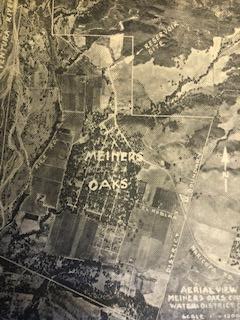
Our problem: growth
The following article was first seen in the Thursday, May 24, 1962 edition of the “OJAI VALLEY NEWS” on the “OPINION PAGE” (Page A-2). It is reprinted here with their permission. It was an “EDITORIAL”, and the author is unknown.
Our problem: growth
A recent population analysis issued by the Ventura county planning staff revealed that the “Ojai planning area,” comprising Ojai, Meiners Oaks and Oak View, was growing slightly faster in the period April 1, 1961 – April 1, 1962, than the county average and about twice the rate of growth of the State of California.
Figures showed the county rate of growth as just over seven percent. This compares with an average of six percent the previous year. This is in line with recently-released statistics which told that Ventura had become the second-fastest growing county in the Los Angeles complex, second only to Orange. Its jump of over one percent in a year presages an increase year by year.
In the Ojai planning area the trend was slightly higher than the county average. We inched upwards to an eight-plus population increase this year. With plenty of land and water available, no slackening in this trend is in sight. No impenetrable barricades will be stretched across Highway 399 on the Arnaz grad or across other access, the Upper Ojai. Employees of the industries moving into the Tri-Cities, Oxnard, Thousand Oaks area will drive here some Sunday afternoon, fall in love with the valley and buy a home. Father will join the roughly 50 percent of the present commuters who live here and work elsewhere.
Another pertinent statistic came to light in the county survey. The highest rate of growth in the county was in the Simi planning area — a remarkable 27 percent increase. Second was Camarillo with 15 percent. Ojai was third at eight-plus.
A look at a county map at this point is revealing. Growth, which has been coming in the past from commuters who work in the Ventura area, will soon make a pincer movement into the valley via the Upper Ojai. Planners count on the development of the large ranches of the Casitas lake perimeter, but the Upper Ojai and even East Ojai’s proximity to the 27 percent increase of the planning area is even more startling. This is where growth is spilling over from the San Fernando valley coming this way along a Santa Susana-Simi-Moorpark — Santa Paula line.
Incidentally, great efforts are being made in Santa Paula to obtain industries. And, down the road a few miles in the Tri-Cities of El Rio, Montalvo and Saticoy, vast acreages are zoned industrial. Recently a 133 acre piece was sold to heavy industry.
Far from Ojai? Not really. From the Tri-Cities it is just as close to Ojai via Santa Paula as it is through Ventura. The same goes for Fillmore, which is due for San Fernando growth.
So here is our problem: proximity to growth. And, to a certain extent the cause of our present problems, for the valley has been growing steadily for a number of years. But the rate is accelerating — probably never to runaway proportions — but nevertheless as consistent as the rising sun. The population should inexorably double in ten years.
So, the future is already upon us. What to do about it?
The obvious answer: plan. The not-so-obvious answer: make decisions.
And, we mean make decisions now. Every decision deferred now means time that cannot be retrieved . . . . more pressure on the day when action is overdue, when action will be forced under pressure, perhaps under controversy, and always under haste, and extra expense.
Honestly now, wouldn’t our valley be a better place to live — a better planned community, if governmental bodies had been ready for growth, such as subdivisions, then years ago.
Only fast, massive, intelligent action on Ojai’s master plan, and by the county on the unincorporated sections of the valley (which are exceptionally vulnerable) can save the valley from a fate it does not want — or deserve.
BIGGERS THE BEE MAN: What’s Doin’ in Meiners
The following article first appeared in the Wednesday, June 5, 1968 edition of “The Ojai Valley News and Oaks Gazette” on Page D-1. That newspaper is now the “Ojai Valley News”. The article is reprinted here with their permission. Effie Skelton is the author. Photos have been inserted into this article by the “Ojai Valley Museum”.
BIGGERS THE BEE MAN
What’s Doin’ in Meiners
by
Effie Skelton
Meiners Oaks continued to expand. On February 15, 1961, another subdivision was added by Griffin and Son, Inc., consisting of seventy two lots, on South Rice Road. Soon the homes were built and filled with new residents.
On January 2, 1946, Mr. and Mrs. J. B. (Josh) Smith, 221 South Poli Street, arrived from Wichita, Kansas, to visit their friends, the Edward Sorensens, who had recently move here from Wichita. They prevailed upon the Smiths to make this their home. At that time, there were many homes being built and carpenter work was plentiful. Smith purchased three lots and started his home.
Now, they have a well-cared-for neat home, fenced, with grounds that are attractively landscaped. There is hardly room in which to put a single plant; for they have fruit trees, bouganvilla, hibiscus, fuchsias, bottle brush, palm trees and Monterey pines. Any corner of their garden would make a lovely picture.
Smith helped build many homes in Ojai Valley. He is now retired. Their hobby is keeping their home in excellent condition, and they are an example of what two people may do to improve their home and make it an asset to the community.
Mr. and Mrs. George Biggers moved to 223 South Padre Juan in 1938, a couple that have not only raised their own large family, but helped other children. They have lived in a house by the side of the road and been a friend of man, of bees, of agriculture and of nature. Biggers is also pastor of the friendly Church of Christ on the corner of Padre Juan and El Roblar.
Biggers experiences with bees have been written up in newspapers and magazines, large and small. He is a man who collects experiences in life as many others may collect pretty rocks. He works with millionaires and the poor, the industrialist and the worker, the sick and the well, and as in Kiplings poem “If”, he has not lost the common touch.
Biggers was born in Oakland, his father moved to San Francisco soon afterwards, where they experienced the 1906 earthquake, and lost everything. His father came near being shot for looting when he was carrying his sewing machine up Nob Hill and was saved by having a picture in machine drawer. The family moved to Monrovia where the father was promotion manager for Fleischman Yeast Company. Then — on to Santa Paula, where he operated a bakery and bought a ranch on Santa Paula Creek, where a cloudburst wiped out their home and possessions.
Biggers became interested in bees at the age of eight, when during a school lunch hour the bees swarmed on an oak limb, he contained them in a burlap sack. His teacher, Iris McIntyre, whose father was a beekeeper, gave him books on bees to read. His high school paper was on bees.
Biggers states that “Mankind can learn valuable lessons from these hard workers. They only stop work to sleep. They have a highly organized society. Duties are assigned to various individuals; there are workers who gather the honey, nurse bees who clean and cool the hive, the guard bees who protect. When bees are on long trips the hives are not forgotten by the bees. To keep the wax from melting and the young bees from dying, the nurse bees are stationed near the frames, fanning them with their wings, some lines fanning in one direction and others in the opposite direction, creating refrigeration rotation. In addition to being wise administrators, the bees are excellent architects. The octagonal cells in their combs are so perfect that scientists found they do not vary in construction from generation to generation. A company supplying needs for operation produced artificial wax combs had the bees looking them over. The bees rejected them, chewed them to bits, and rebuilt them. A California scientist unpuzzled it, the little cells were a fraction of a degree off from being perfect. When built perfectly they accepted them.”

Biggers says that insecticides are wiping out whole colonies of bees, which is creating a danger to American agriculture, as bee pollination is used to increase crops. He moves hives all over California and the western part of the United States. He recently moved 1200 hives to Crowley County, Colorado.
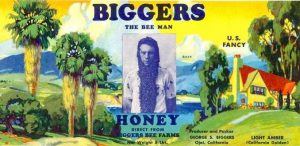
ENJOY THE RURAL SCENE: What’s Doin’ in Meiners
The following article first appeared in the Wednesday, July 3, 1968 edition of “The Ojai Valley News and Oaks Gazette” on Page D-1. That newspaper is now the “Ojai Valley News”. The “Ojai Valley News” graciously allowed us to reprint the article here. The author was Effie Skelton.
ENJOY THE RURAL SCENE
What’s Doin’ in Meiners
by
Effie Skelton
Meiners is where one may awaken mornings to the sounds of the woodpeckers rat-rat-tat on the oaks, inhale the sweet country air and be happy in being an integral part of the pastoral scene. The mind recalls the residents of the past who also experienced this pleasure, the Oak Grove and Chumash Indians, the early pioneers, and those that lived in time of stagecoach. For $1 a stagecoach could be taken from Ventura to Matilija Hot Springs, where the vacationists and fishermen could get to the mountains quickly and easily. In this age of speed with cars, trailers and campers arriving by the hundreds on holidays and weekends we realize there are many who also wish to become an integral part, even for a short time, of this peaceful scene.
Many of the village street and avenue names are Spanish, pertaining to that certain section. Others are in honor of famous men of the early 1800’s, such as, Arnaz Avenue in honor of Don Jose Arnaz. He is credited with the first attempt in subdividing in Ventura, by a try at townsite—laying near the Mission in 1846. He advertised the advantages of his subdivision in eastern American papers, but without response. Arnaz lived in Ventura. He was a merchant, trader, rancher and a native of Spain.
Poli Avenue was named for Dr. M. A. R. de Poli, a native of Spain, who in the 1850’s was the first practicing physician of the Ventura area. He combined medicine with cattle raising and visited patients on horseback.
Padre Juan (Father John) Avenue is named for Father John Comopla, who was a priest at the Ventura Mission from 1861 to 1877.
**
Mr. and Mrs. Robert Clifford recently moved from South La Luna Road into 242 Carrizo Avenue, purchasing the property from W. W. Haley, Carrizo is a short street, formerly consisting of families with children, who are now adolescent, in service or married, leaving the residents on the street missing the laughter and sounds of youth. However, this friendly couple has seven lovely, mannerly and considerate children. Clifford is employed by the Postoffice Department in Ventura. Mrs. Clifford’s hobby is being a good homemaker and working with flowers.
**
A lovely lavender Crepe Myrtle shrub is now in full bloom on the neat lawn of Mr. and Mrs. Archie Horrell, 600 Mesa Drive. They also have many other flowers on their well-kept grounds. Mr. and Mrs. Horrell purchased their ten acre orange grove with its two bedroom home in 1952. He was employed by the Shell Oil for 32 years, retiring in 1956. Mrs. Horrell’s hobby is flowers and Mr. Horrell is supervising his ranch, fishing and spending part of his time in his well-equipped workshop.
**
If there is a watch or clock problem, or a desire to purchase jewelry, why not try the Verkuil Jewelers, 136 El Roblar Drive. Verkuil has many years of experience repairing watches and clocks, beginning at the age of eighteen. He worked for the Bulova Watch Company for thirteen years and downtown Ventura Jeweler for ten years. He maintained his own store in Meiners Oaks from 1947 until 1951. He returned to the village in 1961 to again open a jewelry store. When there are capable people near at hand to serve, there is little need to travel to Timbuctoo to have the same service. Mr. and Mrs. Verkuil have a neat home at 131 South Padre Juan Ave.
**
From the memory store room of Lennie Soper: The Soper family, consisting of the parents, two boys and two girls lived in the original Meiners Ranch house. Soper bought a new piano for the girls. One week after the purchase the ranch house burned, together with all furnishings and the new piano. The Soper’s moved from Meiner’s ranch to the Rice Ranch across the river where Lennie operated a milk and egg route to Matilija Hot Springs. He drove a buckboard pulled by one mule.
NEW RULES FOR KINDERGARTEN ANNOUNCED
The following article was on page 2 of the JULY 16, 1948 edition of THE “OJAI.” It is reprinted here with the permission of the Ojai Valley News. The author is unknown.
NEW RULES FOR KINDERGARTEN ANNOUNCED
Enrollment in the kindergarten classes of the Nordhoff Union Elementary School district will be subject to regulations set up by the school board—regulations made necessary by the lack of sufficient kindergarten space, the coming school year, it was announced today.
With two sessions in the Oak View kindergarten and two at Nordhoff, there were not sufficient accommodations last September and there will be more on a waiting list this coming year, since the new kindergarten at Meiners Oaks will not be completed before February of 1949.
However, there is a solution which should work for the possible benefit of the children in their school work, members of the school board agree.
It is generally accepted that the school entrance age in California is too low, most states setting a higher age. By the sixth grade the average age is a year greater in proportion, showing that the average child either starts in later or has not been promoted at the end of one of the school years. The state convention of elementary school principals last April went on record as favoring a five-year entrance age to kindergarten.
Therefore, all children five years of age or older on September 1, 1948, will be admitted to a Nordhoff kindergarten; those from four years and six months to five years, as of September 1, will be placed on a waiting list and after the first day of school those whose ages are greatest will be notified that they may enter, the number allowed to enter depending upon class space still available.
Registration for kindergarteners or other pupils new to the district will be handled in the school office in Ojai beginning August 2. A birth certificate or other official evidence of correct birthdate must be shown to gain enrollment in either kindergarten or first grade. The school office will be open Mondays through Fridays from 9 am to 12 noon and 1 to 4 pm beginning with August 2. In general, the school office will be closed during the month of July.
For the convenience of Oak View children, registration there will be conducted on or about September 1 at that school; an announcement will be given later, after Mrs. Ethel Eitens, principal, has returned from her summer school work. Casitas Springs children will enroll the first day of school, September 13.
John Roine and the Acacia Mansion
The following is the text of a talk given by historian and author Craig Walker at the Ojai Valley Museum’s 2018 Annual Meeting at the Acacia Mansion.
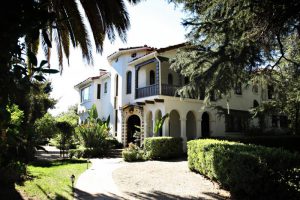
The Acacia Mansion was originally named Acacia Lodge. The acacia tree was a symbol of purity, renewal, and immortality. A lodge is a meeting place; it is an organizational term used by Theosophists—as in The Ojai Lodge. This large, two-story home has 10 rooms and is a wonderful blend of both formal and exotic architecture. We are so fortunate the building has retained its integrity of design over nearly 90 years. It is now a Ventura County landmark and eligible for the National register of historic places.
Designed in 1927, the Acacia Lodge was one of the first homes built here in Meiners Oaks. If you look at photographs taken from the hill above the Ranch House around 1928 or 29, you see this house standing pretty much by itself. In 1924, Meiners Oaks was a 1,200 acre working ranch. By 1927 there were only five families living here.
Although the architect, John Roine, isn’t the most famous architect to have worked in the Ojai Valley, the house is a genuine masterpiece of Spanish-Revival architecture… rivaling those designed by more famous architects like Wallace Neff, George Washington Smith, and Mead & Requa.
The Architecture is Spanish-Moorish, with a heavy emphasis on the “Moorish.” All Spanish architecture has Moorish features.
Moorish culture–“North-African Arabic”–influenced all Spanish Architecture because the Moors invaded Spain in 711 a.d. and ruled the Iberian peninsula for over 700 years. Examples of Moorish architecture in Spain include the Alhambra in Granada and La Mezquita in Cordoba.
Some California architects, however, included more Moorish features than others. Richard Requa, the primary architect of Ojai’s downtown buildings, really liked Moorish architecture. He travelled extensively in North Africa making lots of sketches, but his Moorish design elements were much more subtle than Roine’s. The Ojai Arcade is a good example. You can see the Moorish influence, but the emphasis is more on the California Mission style. It should be noted that the Moorish influence on the Arcade was diminished when the two spires on top of the Arcade were removed in the 1940s or 50s.
The Acacia Mansion on the other hand has much more of an exotic, Moorish look. It more closely resembles the buildings constructed at Krotona when it was located in Hollywood. (More about that later.)
Madeline Baird, the original owner of the Acacia Mansion, spared no expense in creating this beautiful, eclectic work of architecture. Most of the materials and decor were imported from Europe. This included terrazzo tiles, pink marble, mahogany doors, Italian lamps, etc. A particularly American feature, however, are the Ernest Batchelder tile fireplaces in the living room and master bedroom. Batchelder’s tiles, manufactured in Pasadena, were used in many of California’s finest Craftsman-style homes.

Skilled craftsmen were also imported..from Finland. Some of the descendants of these workers still live in Meiners Oaks. One of these craftsmen was Uno-Pal Kangas, a Finnish sculptor who created a reflecting pool and a fountain for the Mansion. During the depression, Kangas created many statues for the New Deal “Works Progress Administration.” One of his projects was the Statue of Father Serra in front of the Ventura County Courthouse (now Ventura City Hall). Kangas’ concrete statue was recently replaced with a bronze casting of the original. He lived and worked in M.O. for the rest of his life.
The owners of the house were David and Madeline Baird, who immigrated here from Canada. They commissioned the house in 1927; Mr. Baird died before the home was completed two years later in 1929. The Bairds made their fortune in the fish industry in Nova Scotia. David was known as “The Sardine King of Canada.”
The Bairds were Theosophists who came here to be part of the new Theosophical Center Annie Besant was creating in the Ojai Valley. Besant came to Ojai in 1926 to meet with Krishnamurti and begin purchasing property for the new center.
Annie Besant bought 200 acres across Lomita that was to be the valley’s spiritual center. Krishnamurti began holding talks in the Oak Grove in 1928. This area across the street was named Starland after the Order of the Star, Krishnamurti’s religious organization. Besant purchased 500 Acres in the Upper Ojai to be the organization’s educational center, with a Theosophical school and college. Her plan was that she would head the educational center and Krishnamurti would head the spiritual center.
Meiners Oaks was to be a community where Theosophists would live. Siete Robles was also developed as a housing tract for Theosophists. Ojai was advertised around the world for Theosophists to come and purchase lots. John Roine, the architect, advertised his services as architect and builder. The Bairds were among the first to respond.
John Roine was the architect of the Acacia Mansion. He, too, was a Theosophist. He immigrated to California from Finland in 1916 at the age of 39. He settled first at Krotona Hollywood, a Theosophical Colony and Educational Center, located in Hollywood. It was nestled in Beachwood Canyon–under the Hollywood Sign. He most likely began working as a construction manager and builder at Krotona Hollywood. He also was also very active in Theosophical affairs, writing articles, speaking at conventions, and serving as a liaison with the Finnish Theosophical Lodge.
As a builder at Krotona Hollywood, Roine worked under some of the most accomplished architects in Southern California. The Theosophists loved fine architecture, and they hired only the best, including.
- Mead & Requa.
- Arthur and Albert Heineman.
- Marie Russak Hotchener.
The style of architecture at Krotona Hollywood was much like that of the Acacia Mansion… Spanish-Revival with a BIG dose of Moorish design elements. The buildings there were very exotic! One of the more beautiful buildings was named Moorcrest. It was designed by Marie Russak Hotchener, a self-educated architect who was a former opera star. Two early residents of Moorcrest were Charlie Chaplin and Mary Astor—both Theosophists working in Hollywood’s film industry.
Roine also worked on the Pilgrimage Theater in Los Angeles. On that project, he worked under the renowned architect Bernard Maybeck. Maybeck designed the Palace of Fine Arts in San Francisco and was Julia Morgan’s mentor. Julia Morgan designed the Pierpont-Ginn House here in Ojai, and Hearst Castle in San Simeon.
So, Roine learned architecture on the job, while working at Krotona Hollywood on all its magnificent, exotic buildings.
In 1922 Krishnamurti came to Ojai and established a home in the east end on McAndrew Road. He was the Theosophist’s spiritual leader at the time, so in 1924, Albert P. Warrington, the head of Krotona, moved the organization to Ojai. Warrington wanted the new Krotona buildings to match Libbey’s downtown, so the Krotona buildings in Ojai were done in a more traditional Spanish style. Robert Stacy-Judd was the architect.
John Roine followed Krotona to Ojai in 1926 and lived here full-time for about 9 years. By then, he was a skilled architect, with an architectural office located in the Arcade. He designed and built many buildings and homes in Ojai in addition to the Acacia Mansion.
- In 1926 Roine was hired by Frank Barrington to make major additions to the El Roblar Hotel (Now the Oaks at Ojai). Roine partnered with Carleton Winslow (architect of the Ojai Library & Presbyterian Church) to add the whole west wing to the El Robar. His addition extended the original building 38 feet west and 77 feet north—adding 16 new rooms, each with a private bath.
- In 1926 Roine made additions to Arya Vihara (Krishnamurti’s guest house on McAndrew Road) in preparation for Annie Besant’s visit in 1926-27. He added a study and meeting room so Dr. Besant could continue her extensive work in religion and politics during her stay here in Ojai.
- In 1927, Roine was hired to add 4 new arches to the east end of the Ojai Arcade. Both the East end and West end of the Arcade were remodeled that year. Robert Winfield worked on the West end, remodeling the Arcade in front of the old Clark livery; Roine designed and built the 4 arches at the East end.
- In 1929, Roine designed and built the original Liberal Catholic Church, which still exists as a social hall at the LCC out on Ojai Avenue past Gridley. It was originally built in M.O., but was later moved to the East End site when the church expanded. Roine, by the way, was the first priest ordained in the Ojai Liberal Catholic Church.
- From 1927 to 1929, Roine worked on The Acacia Lodge, now known at the Acacia Mansion.
- In 1930, he designed and built The Pleiades, a house out in Siete Robles that is known today as “the Taj Mahal.” Edward Martin and his wife, Rhoda, wanted to build a home that would honor Krishnamurti. Rhoda named the house “The Pleiades” because Krishnamurti’s Astrological name was Alcyone, which is the brightest star in the Pleiades star cluster in the Constellation Taurus, Krishnamurti’s Astrological sign.
- Roine designed numerous other small, Spanish-style homes around the Ojai Valley: There’s one down the street, one on Aliso across from the Presbyterian Church, one on Thacher Road…and several others. There may be quite a few more in the valley we don’t know about.
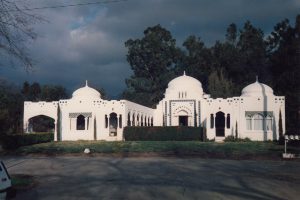
Roine moved back to Los Angeles in 1935, but he continued to visit Ojai frequently. It’s possible he came back to Ojai at the end of his life. His last known address was, ironically, the Acacias…the nursing home located across the street from Grey Gables.
He got Meiners O. for unpaid debt
The following article first appeared in the December 3, 1969 edition of the Ojai Valley News. It is reprinted here with their permission. The photo of John Meiners is used here by courtesy of the Ojai Valley News. The other photos were added by the Ojai Valley Museum.
He got Meiners O. for unpaid debt
by
Ed Wenig
Meiners Oaks, a community where nearly every home is under a Live Oak tree, takes its name from John Meiners, who owned the large area for many years.
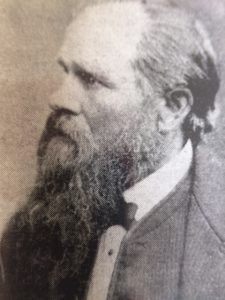
John Meiners, native of Germany, had come to the United States about 1848 and had established a successful brewery business in Milwaukee. He acquired this Ojai ranch in the seventies, sight unseen, as a result of an unpaid debt. When he heard that his friend, Edward D. Holton, a Milwaukee banker, was going to California for a brief trip, Meiners asked him to see the property he had acquired. Mr. Holton’s evaluation was perhaps it was the largest oak grove on level land in Southern California, much of it so dense that the ground was in continuous shade. Furthermore, to his surprise, Meiners discovered that the climate of the valley was good for his asthma.
Hogs grazed there
For a long time the oak grove was fenced, and provided pasture for a large herd of hogs. All traffic from Ojai to Matilija went on a private road through the Meiners property, using a gate which was supposed to be kept closed. So many people went through the gate without closing it that in 1893, the manager of the ranch, P. W. Soper, locked the gate. With the Meiners road closed the only way of getting the mail to Matilija by stagecoach was a roundabout one by Rice Rd. A news item in “The Ojai” related that, as Rice Road had been flooded, “the mail was sent up to Matilija last night on horseback, the rider going across the back hill country. . .” However, Mr. Soper later gave several keys to A. W. Blumberg, operator of Matilija Hot Springs, with the stipulation that they be used only by mail carriers and scheduled stagecoach drivers.
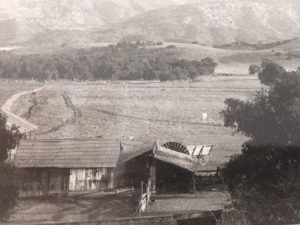
In 1896, the big barn, on the Meiners Ranch, located approximately where the Ranch House Restaurant is now, caught fire one evening about midnight. No fire fighting equipment was available. Twenty horses, many tons of hay, harness, and farm implements were completely destroyed. “The Ojai” of February 15, 1896 reported, “Through the flames the horses could be seen plunging and dashing about insanely in the midst of the burning firey furnace; twenty fell victims without a single rescue.” But, the article goes on to state further, “Mr. Meiners built a large temporary barn on Monday, and the work of the great ranch goes on energetically.”
House still stands
The Milwaukee brewer lived on his ranch intermittently from the 1880’s until his death in the valley in 1898. His original big house still stands on the hill above the Ranch House Restaurant and is now used by the Happy Valley School.
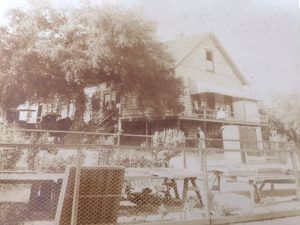
John Meiners organized his ever-increasing acreage into a very productive ranch. Several hundred acres to the north of the oak grove were planted in oranges, lemons, prunes, apricots and apples. P. W. Soper, father of the late “Pop” Soper, was general manager of the Meiners Ranch, and lessee of 90 acres of Texas red oats, 90 acres of wheat, and 200 acres of barley. A visitor who toured the ranch with Mr. Meiners in 1897 wrote, “At the Meiners Ranch we saw stalks of oats that measured 7 feet 7 inches.”
To visualize the vast area, the ranch can be described as bounded on the south by the hills of the Happy Valley School [Oak Grove School now], on the west by Rice Road, and on the north by the foothills near Cozy Dell Canyon, and on the east by a line running through the junction of Highway 33 and El Roblar St., north and south.
The forebears of several of the present day residents of Ojai Valley came here as a result of John Meiners’ interest in his ranch. The grand-daughters of Edward D. Holton, who made the original favorable report concerning the ranch of Mr. Meiners, and the Ojai Valley, are Miss Alice and Helen Robertson of the East Valley, and his great grand-daughter, Mrs. Anson Thacher. Otto Busch came to the ranch as manager in 1907, and his son, Geo. Busch, now retired, was one of Ojai’s postmasters.
Valley Market Owner Can Do Anything
The following article was run in the August 13, 1999 edition of the Ojai Valley News. It is reprinted here with their permission. The photo in the article was taken by its author.
Valley Market Owner Can Do Anything
by
Jon Myhre
OVN contributor
When Tony Leckie, owner of the Valley Market in Meiners Oaks, emerged unscathed from a walk across the bed of hot coals during an event conducted by the popular Anthony Robbins, he felt he could do anything.
And that “anything” included giving the people of the Ojai Valley a well-run, independent grocery store.
To do that, Leckie knew he needed a highly motivated team, not just a group of employees putting in time. Therefore, instead of offering just an hourly wage with a few benefits, he made it possible for his workers to share ownership of the business through stock options, and to financially benefit when sales goals were met.
In addition to those motivational factors, and Anthony Robbins-inspired “power hour” for all workers, including Leckie, is held at 3 p.m. every day to get “pumped up” for the peak business hours from 3 to 6 p.m.
During this brief, but energetic, time frame, employees go up front, stand in a line, massage each others shoulders for 30 seconds and “power clap” before going back to work.
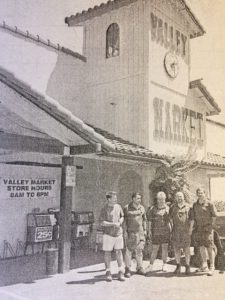
Leckie’s team consists of Hal Moore, co-owner and right-hand man; Aaron Johnson, meat manager and owner of Q-Time BBQ Co., which is run within the store; Laura Leckie; and Carlos Martinez, all Ojai Valley natives who graduated from Nordhoff High School.
Their effectiveness is immediately apparent upon entering the market, which has a clean, wholesome atmosphere, as well as friendly service and a wide selection of beautifully displayed merchandise.
An electric train running around the sales area adds a touch of humor and fun.
“Shopping is a tedious task no one likes to do, so we’re trying to make it as much fun as we can while sticking to being a good grocery store,” Leckie said.
Before becoming owner of Valley Market, Leckie accumulated 17 years of food retailing experience as an employee of Dahl’s Market in Oak View and then the Locker Market in Ojai. During those years he developed his business philosophy both through his own experiences, as well as by reading all he could and then putting what he learned to good use.
Presently, Leckie teaches karate and kamikaze kick boxing at Meiners Oaks Elementary School and conducts workouts at a location adjacent to Don’s Gym.
Leckie believes in all type of independent stores, and said, “They all work to make the community around us a better place to live.”
Consequently, he urges the citizens of the valley to shop at the local independents rather than the chain stores who, he said, do not offer lower prices and greater selection, in spite of their advertising.
To prove the point, he welcomes selection and price comparisons and furnishes information on Valley Market specials by telephone at 640-SAVE (7283).
None of the profits of the Valley Market team leave the valley. The market sells scrip to the Meiners Oaks and Mira Monte Elementary Schools; donated ingredients for Lions Club pancake breakfasts; conducted a hot dog and bake sale for Meiners Oaks Elementary School; and has plans for a carnival in the parking lot involving as many community organizations as possible.
Effie Skelton
This story was written by Cricket Twichell. It is based on a piece she wrote for the Ojai Valley News in the 1980’s.
Effie Skelton
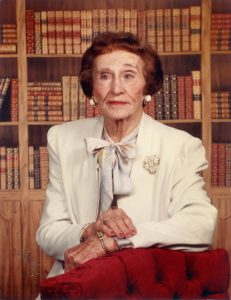 This lady knew about small beginnings. Born in Oklahoma around the turn of the century, Effie Skelton weighed in at 1 1/2 pounds. Told there was no way this child could survive, the Cherokee Indian auntie assisting at Effie’s birth ignored the doctor’s grim prognosis, wrapped Effie in soft cotton, tucked her into a shoe box which she placed in the warming oven of the wood stove and then every hour fed her a drop or two of blackberry brandy. Effie kicked into high gear and eventually became a driving force in the Ojai.
This lady knew about small beginnings. Born in Oklahoma around the turn of the century, Effie Skelton weighed in at 1 1/2 pounds. Told there was no way this child could survive, the Cherokee Indian auntie assisting at Effie’s birth ignored the doctor’s grim prognosis, wrapped Effie in soft cotton, tucked her into a shoe box which she placed in the warming oven of the wood stove and then every hour fed her a drop or two of blackberry brandy. Effie kicked into high gear and eventually became a driving force in the Ojai.
After graduating from business college, Effie saved her hard-earned money and in 1927 bought a brand new Pontiac. She had an agenda— to immediately head out west—by herself— to California. “I didn’t know how to drive backwards” said Effie” but that didn’t matter. I was only going forward.”
Ending up in Ventura, Effie married a young man who worked for Shell Oil Company. They moved to Ojai where she raised 3 children and became a realtor, specializing in Meiners Oaks properties. Her weekly column in the Ojai Valley News— “What’s Doin’ in Meiners Oaks”—- had a devoted , down-home following.
Over the years Effie became concerned because so many artifacts connected with the pioneer days of the Ojai were leaving the valley. If only we had a museum which would house these papers, tools, and etc of a bygone era! The more she thought about this, the more zealous she became in her determination to stop the hemorrhaging of the Ojai’s historical items.
Other community leaders jumped on Effie’s band wagon. Bob Browne, a local anthropologist, history buff and handyman, shared her enthusiasm for creating a museum and historical society in the Ojai. He had bought a house in the highlands above Miramonte and to his delight discovered it had been the site of a Chumash Indian village. After UCLA conducted a full-blown archaeological dig on his property, Bob wanted to house the relics which had surfaced in a place where they could be enjoyed and appreciated by.the community at large. He and Effie joined forces; and soon Lynn Rains, Arthur Waite, Bill Bowie, Lois Powers and Elizabeth Thacher hopped on board.
The founding members of the museum began working the room, asking members of Ojai pioneer families to donate articles to their worthy cause. The Forest Service offered space to store the memorabilia which came pouring in. When they needed more room, Walter Gamulski offered storage space where the American Legion Hall is today if the museum group would pay the taxes and the insurance. You betcha’!
Effie and her friends put donation cans in banks, stores, motels and public buildings. She wrote articles in the Ojai Valley News to keep the community appraised of the progress of her venture and to remind readers to donate antiques etc to add to the ever-growing collections.
In 1966, 50 years ago, the Museum opened up for business in the Arcade where the realtors office is today. At the opening reception punch was served in attractive bowls the early Chinese settlers had used for washing their hair. That day Effie got to raise two flags over the new Museum, one which had flown over the capitol in Sacramento and one which had flown over the White House in Washington. Ojai had itself a bona fide Museum!
As the collections continued to grow, in 1979 a new home was found for the fledgling Museum— on Montgomery Street at the former firehouse which had been built in 1937 with WPA funds. Bud Bower donated the services of Ojai Van Lines to transport the possessions to the new location; Bob Browne and his crew built dioramas depicting animals in the Sespe back country; eye-catching displays were concocted. People came. In one year Effie, who manned the guest book every day for over 20 years, counted 7,000 visitors from 31 countries.
What started as an idea in Effie’s noggin, grew into an institution which is thriving today. Like her old Pontiac, the Museum only goes forward!
